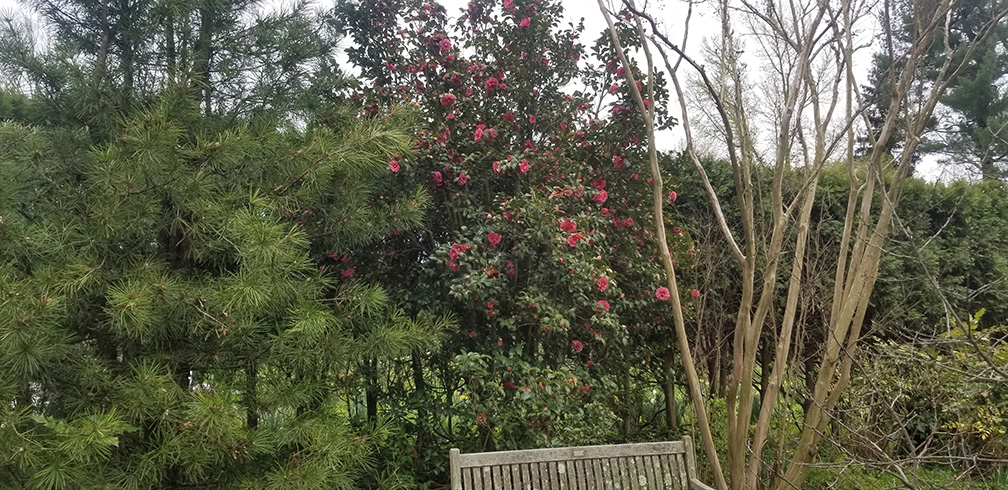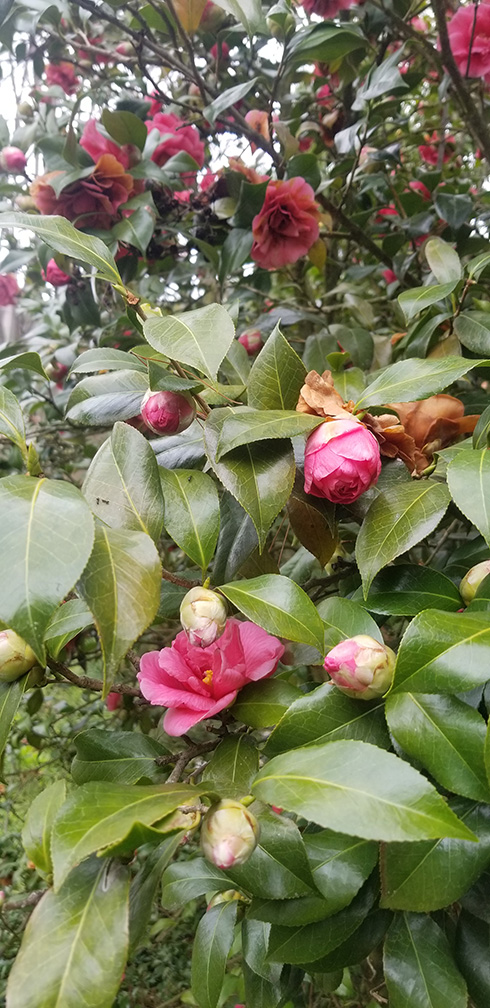By Grace Harbison, Former Ambler Arboretum Student Gardener


Camellias are a beautiful plant to admire. Whether it is a planted back against a hedge, or situated along the outside edge of a garden bed, it is sure to attract attention with its bold and bright rose-like flowers. Even after the blooms have fallen off in spring, the plant still maintains its showy appearance through its bright, glossy leaves.
The ancient history of Camellias originates in the southeastern temperate forests and subtropical forests of Asia. Many different species were used to make tea but the species, Camellia sinensis, stands out as having the best leaves and buds to make tea. In China, the tea had various uses as it was valued for its many medicinal properties. The tea contains useful health components such as caffeine, amino acids, polyphenols and antioxidants known as flavonoids. These properties help the tea to treat asthma, bacterial infections, and even heart problems. Even though Chinese and Japanese botanists were first known to cultivate Camellias, the plant is named after the Jesuit missionary and botanist Georg Joseph Kamel. After Kamel’s time in Asia, he introduced the plant in Europe during the 17th century. This introduction helped to highlight the plants wonderful ornamental qualities. Finally, during the colonial era of the western countries, the plant gained widespread popularity as many wealthy colonists collected the plant for their vast gardens and large conservatories.
Today, as a result of heavy cultivation, there are more than 20,000 different Camellia varieties. Camellias are understory plants that grow into large shrubs or into medium sized trees if they are left alone. They occur in forests that are either dense or sparse and moderately moist or dry. The leaves feel thick and have a dark green, glossy appearance to them. Along the margins, the leaves are lined with finely minute serrations. The flowers can be single flowered, semi-doubled or doubled flowered and come in shades of white, yellow, red, and pink. In Japan, where thousands can be seen blooming at once, it is known as the Japanese Rose. Our Japanese Camellia (Camellia japonica), located in the Albright Winter Garden, is a popular shrub with multiple stems and light pink rose shaped petals that give a flower spread of 3-6 inches. Since Camellias are temperate and humidity-loving plants, the Japanese Camellia is planted against a tall hedge to protect it from harsh winds and the cold winter temperatures.
Much of the symbolism in a Camellia is attributed to the unique way the inflorescence falls off. Most flowering species lose their petals first and then the calyx, the outside sepals.
However, the Camellia loses its petals and calyx all at once. In Chinese symbolism, the green calyx, the part that holds the flower in place, represents the man, the protector, while the petals represents the women. This symbolism represents the balance and longevity that are needed in a loving relationship. Camellias symmetrical flower growth has also helped the plant to symbolize perfection and excellence. In Japan, the flower symbolizes divinity and is commonly used in religious and sacred ceremonies. In Korea, the flowers symbolize the union of faithfulness and longevity. Since 1200 B.C., the flowers have been a staple in Korean weddings. In the United States, the Camellia is the state flower of Alabama and symbolizes beauty. This versatile and attractive plant has its roots in Asia but has pleased gardeners and admirers alike throughout the world over the last several centuries.
Reference Links
https://www.trianglegardener.com/heritage-camellias-a-growing-history%E2%80%A8/ https://flower-meanings.com/camellia-flower-meaning/ https://www.americancamellias.com/care-culture-resources/the-camellia-family/camellia-species
https://www.americancamellias.com/care-culture-resources/history-of-camellias

